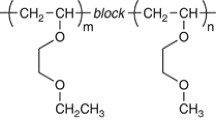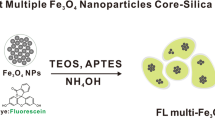Abstract
Herein, in a one-pot procedure, fluorescent silica submicrospheres (FSSMSs) with ordered composite structure were facilely fabricated by the approach of AIE-amphiphile-induced hierarchical order self-assembly. A key factor is the use of an AIE-active amphiphile as both light-emitting source and structure-directing agent. As expected, the fluorescent micelles formed by self-assembly of the AIE-active amphiphile were orderly assembled in the silica networks through noncovalent attachment in the system. The resultant FSSMSs have uniform particle size and morphology, demonstrating excellent properties, such as ordered structure, good monodispersity, excellent photostability, no fluorescence leakage and easy synthesis. The results demonstrate that ordered composite structure in FSSMSs is beneficial for its photostability as well as structural stability. As a test proof, the FSSMSs with a mean size of 0.6 µm were used to check the integrity of microfiltration membranes with 0.45 µm pores. A simple and convenient approach of using FSSMSs for assessing the level of membrane integrity was proposed. In addition, the FSSMSs composite materials show unexpectedly excitation-dependent emission properties. The special FSSMSs have promising application in multicolor display and bioimaging.





Similar content being viewed by others
References
Ow H, Larson DR, Srivastava M, Baird BA, Webb WW, Wiesner U (2005) Bright and stable core-shell fluorescent silica nanoparticles. Nano Lett 5:113–117
Kim T, Jang H, Kim S, Lee J-H, Kim S-Y, Jeon NL, Song JM, Min D-H (2018) Synthesis of fluorescent Au nanocrystals-silica hybrid nanocomposite (FLASH) with enhanced optical features for bioimaging and photodynamic activity. Langmuir 34:173–178
Perton F, Harlepp S, Follain G, Parkhomenko K, Goetz JG, Bégin-Colin S, Mertz D (2019) Wrapped stellate silica nanocomposites as biocompatible luminescent nanoplatforms assessed in vivo. J Colloid Interface Sci 542:469–482
Insin N, Tracy JB, Lee H, Zimmer JP, Westervelt RM, Bawendi MG (2008) Incorporation of iron oxide nanoparticles and quantum dots into silica microspheres. ACS Nano 2:197–202
Li W, Chun F, Fan X, Deng W, Xie M, Luo C, Yang S, Osman H, Liu C, Yang W (2019) Ethanol-water-assisted room temperature synthesis of CsPbBr 3/SiO2 nanocomposites with high stability in ethanol. J Mater Sci 54:3786–3794
Zhang S, Liu R, Cui Q, Yang Y, Cao Q, Xu W, Li L (2017) Ultrabright fluorescent silica nanoparticles embedded with conjugated oligomers and their application in latent fingerprint detection. ACS Appl Mater Interfaces 9:44134–44145
Zhang W-H, Hu X-X, Zhang X-B (2016) Dye-doped fluorescent silica nanoparticles for live cell and in vivo bio-imaging. Nanomaterials 6:81–97
Palantavida S, Tang R, Sudlov GP, Akers WJ, Achilefu S, Sokolov I (2014) Ultrabright NIR fluorescent mesoporous silica nanoparticles. J Mater Chem B 2:3107–3114
Alberto G, Caputo G, Viscardi G, Coluccia S, Martra G (2012) Molecular engineering of hybrid dye-silica fluorescent nanoparticles: influence of the dye structure on the distribution of fluorophores and consequent photoemission brightness. Chem Mater 24:2792–2801
Joshi PB, Zhang P (2015) Facile capture of conjugated polymer nanodots in silica nanoparticles to facilitate surface modification. J Mater Sci 50:3597–3603
Ma K, Mendoza C, Hanson M, Werner-Zwanziger U, Zwanziger J, Wiesner U (2015) Control of ultrasmall sub-10 nm ligand-functionalized fluorescent core-shell silica nanoparticle growth in water. Chem Mater 27:4119–4133
Carbonaro CM, Orrù F, Ricci PC, Ardu A, Corpino R, Chiriu D, Angius F, Mura A, Cannas C (2016) High efficient fluorescent stable colloidal sealed dye-doped mesostructured silica nanoparticles. Microporous Mesoporous Mater 225:432–439
Yuan WZ, Lu P, Chen S, Lam JW, Wang Z, Liu Y, Kwok HS, Ma Y, Tang BZ (2010) Changing the behavior of chromophores from aggregation-caused quenching to aggre-gation-induced emission: development of highly efficient light emitters in the solid state. Adv Mater 22:2159–2163
Deng T, Li J-S, Jiang J-H, Shen G-L, Yu R-Q (2006) Preparation of near-IR fluorescent nanoparticles for fluorescence-anisotropy-based immunoagglutination assay in Whole Blood. Adv Funct Mater 16:2147–2155
Huang L, Yang S, Chen J, Tian J, Huang Q, Huang H, Wen Y, Deng F, Zhang X, Wei Y (2019) A facile surface modification strategy for fabrication of fluorescent silica nanoparticles with the aggregation-induced emission dye through surface-initiated cationic ring opening polymerization. Mater Sci Eng C Mater Biol Appl 94:270–278
Mao L, Zhang X, Wei Y (2019) Recent advances and progress for the fabrication and surface modification of AIE-active organic-inorganic luminescent composites. Chinese J Polym Sci 37:340–351
Mao L, Liu M, Xu D, Wan Q, Huang Q, Jiang R, Shi Y, Deng F, Zhang X, Wei Y (2017) Synthesis, surface modification and biological imaging of aggregation-induced emission (AIE) dye doped silica nanoparticles. Appl Surf Sci 403:396–402
Li W, Qiu Z, Tebyetekerwa M, Zhang J, Wang Y, Gao T, Wang J, Ding Y, Xie Y (2019) Preparation of silica/polymer nanocomposites with aggregation-induced emission properties as fluorescent responsive coatings. Prog Org Coat 127:8–15
Zhang X, Zhang X, Wang S, Liu M, Zhang Y, Tao L, Wei Y (2013) Facile incorporation of aggregation-induced emission materials into mesoporous silica nanoparticles for intracellular imaging and cancer therapy. ACS Appl Mater Interfaces 5:1943–1947
Faisal M, Hong Y, Liu J, Yu Y, Lam JWY, Qin A, Lu P, Tang BZ (2010) Fabrication of fluorescent silica nanoparticles hybridized with AIE luminogens and exploration of their applications as nanobiosensors in intracellular imaging. Chem Eur J 16:4266–4272
Mahtab F, Lam JWY, Yu Y, Liu J, Yuan W, Lu P, Tang BZ (2011) Covalent immobilization of aggregation-induced emission luminogens in silica nanoparticles through click reaction. Small 7:1448–1455
Blaaderen AV, Vrij A (1992) Synthesis and characterization of colloidal dispersions of fluorescent, monodisperse silica spheres. Langmuir 8:2921–2931
Chen K, Kang M, Lu A, Chen L, Song L, Sun R (2019) Visualization of silica dispersion states in silicone rubber by fluorescent labeling. J Mater Sci 54:5149–5159
Liu C, Cui Q, Wang J, Liu Y, Chen J (2016) Autofluorescent micelles self-assembled from an AIE-active luminogen containing an intrinsic unconventional fluorophore. Soft Matter 12:4295–4299
Huang D, Zhou H, Gong X, Gao J (2017) Silica sub-microspheres induce autophagy in an endocytosis dependent manner. RSC Adv 7:12496–12502
Yu M, Lin J, Fang JY (2005) Silica spheres coated with YVO4:Eu3+ layers via sol-gel process: a simple method to obtain spherical core-shell phosphors. Chem Mater 17:1783–1791
Li M, Cheng F, Xue C, Wang H, Chen C, Du Q, Ge D, Sun B (2019) Surface modification of stöber silica nanoparticles with controlled moiety densities determines their cytotoxicity profiles in macrophages. Langmuir 35:14688–14695
Dong H, Brennan JD (2015) Tailoring the properties of sub-3 µm silica core-shell particles prepared by a multilayer-by multilayer process. J Colloid Interface Sci 437:50–57
Voronin EF, Gun’ko VM, Guzenko NV, Pakhlov EM, Nosach LV, Leboda R, Skubiszewska-Zieba J, Malysheva ML, Borysenko MV, Chuiko AA (2004) Interaction of poly(ethylene oxide) with fumed silica. J Colloid Interface Sci 279:326–340
Porrès L, Holland A, Pålsson L-O, Monkman AP, Kemp C, Beeby A (2006) Absolute measurements of photoluminescence quantum yields of solutions using an integrating sphere. J Fluoresc 16:267–273
Chen X, Luo W, Ma H, Peng Q, Yuan WZ, Zhang Y (2017) Prevalent intrinsic emission from nonaromatic amino acids and poly(amino acids). Sci China Chem 61:351–359
Jiao L, Song F, Zhang B, Ning H, Cui J, Peng X (2017) Improving brightness and photostability of NIR fluorescent silica nanoparticles through rational fine-tuning of the covalent encapsulation methods. J Mater Chem B 5:5278–5283
Sun Y-P, Zhou B, Lin Y, Wang W, Fernando KAS, Pathak P, Meziani MJ, Harruff BA, Wang X, Wang H, Luo PG, Yang H, Kose ME, Chen B, Veca LM, Xie S-Y (2006) Quantum-sized carbon dots for bright and colouful photoluminescence. J Am Chem Soc 128:7756–7757
Li H, He X, Kang Z, Huang H, Liu Y, Liu J, Lian S, Tsang CHA, Yang X, Lee ST (2010) Water-soluble fluorescent carbon quantum dots and photocatalyst design. Angew Chem Int Ed 49:4430–4434
Van Dam B, Nie H, Ju B, Marino E, Paulusse JMJ, Schall P, Li M, Dohnalová K (2017) Excitation-dependent photoluminescence from single-carbon dots. Small 13:1702098
Nie H, Li M, Li Q, Liang S, Tan Y, Sheng L, Shi W, Zhang SX-A (2014) Carbon dots with continuously tunable full-color emission and their application in ratiometric pH sensing. Chem Mater 26:3104–3112
Pan L, Sun S, Zhang A, Jiang K, Zhang L, Dong C, Huang Q, Wu A, Lin H (2015) Truly fluorescent excitation-dependent carbon dots and their applications in multicolor cellular imaging and multidimensional sensing. Adv Mater 27:7782–7787
Sharma A, Gadly T, Gupta A, Ballal A, Ghosh SK, Kumbhakar M (2016) Origin of excitation dependent fluorescent in carbon nanodots. J Phys Chem Lett 7:3695–3702
Li S, Zhou S, Xu H, Xiao L, Wang Y, Shen H, Wang H, Yuan Q (2016) Luminescent properties and sensing performance of a carbon quantum dot encapsulated mesoporous silica/polyacrylonitrile electrospun nanofibrous membrane. J Mater Sci 51:6801–6811
Choi SH, Yang J, Suh C, Cho J (2011) Use of fluorescent silica particles for checking the integrity of microfiltration membranes. J Membr Sci 367:306–313
Acknowledgements
The authors thank Dr. M.-X. Chen from Beijing University for the quantum yield and fluorescence lifetime measurements for us.
Author information
Authors and Affiliations
Corresponding author
Ethics declarations
Conflict of interest
The authors declare that they have no conflict of interest.
Additional information
Publisher's Note
Springer Nature remains neutral with regard to jurisdictional claims in published maps and institutional affiliations.
Electronic supplementary material
Below is the link to the electronic supplementary material.
Rights and permissions
About this article
Cite this article
Liu, C., Zhu, F., Zhang, Y. et al. AIE-amphiphile-induced self-assembly of fluorescent silica submicrospheres with ordered composite structure. J Mater Sci 55, 11203–11212 (2020). https://doi.org/10.1007/s10853-020-04787-0
Received:
Accepted:
Published:
Issue Date:
DOI: https://doi.org/10.1007/s10853-020-04787-0




